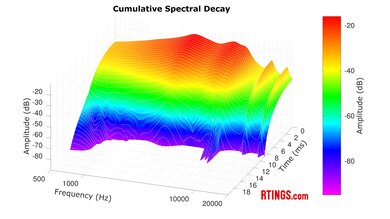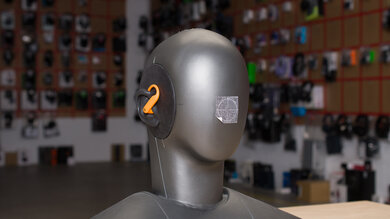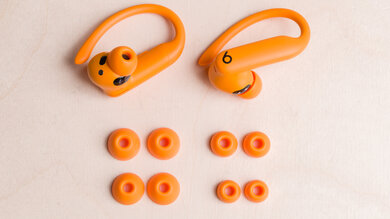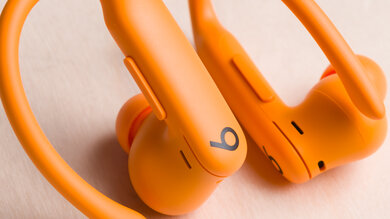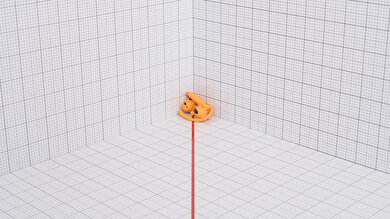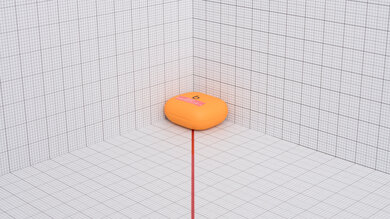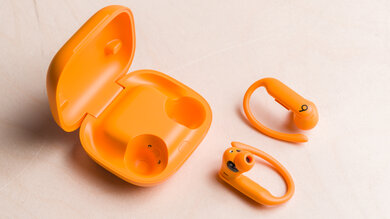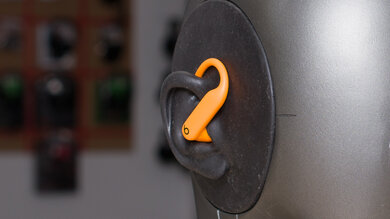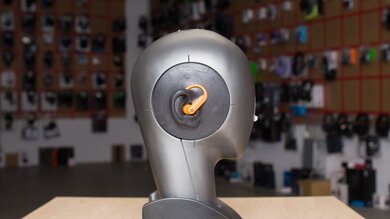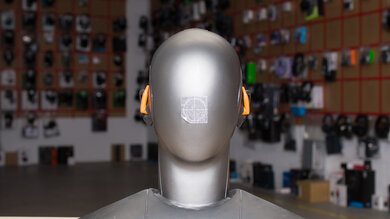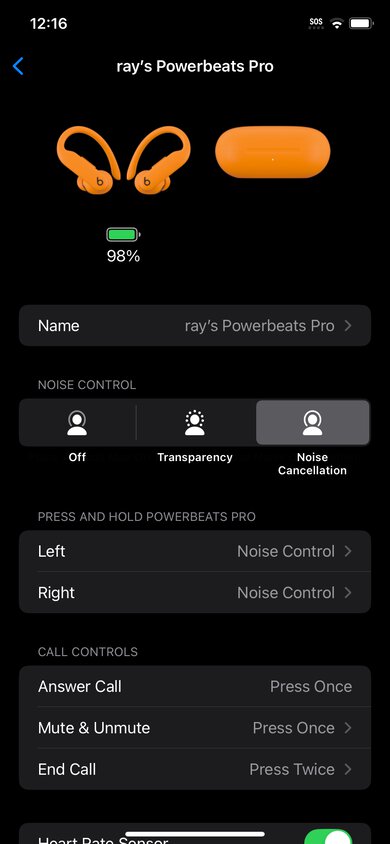The Beats Powerbeats Pro 2 are the long-awaited sequel to 2019's Beats Powerbeats Pro Truly Wireless, but this time they're back with active noise cancellation (ANC). Like the previous generation, some things remain the same, like an IPX4 rating and a broadly similar over-ear hooked design geared towards athletes or anyone who prefers extra fit security. Many updates are internal or software-based, like onboard heart monitors, Apple's H2 chip, and Apple Spatial Audio compatibility.
Our Verdict
The Beats Powerbeats Pro 2 are impressive for sports and fitness use. Their fit is very secure, thanks to a choice of five ear tips and a well-built, flexible, nickel-titanium alloy over-ear hook that's covered in comfortable silicone. Their powerful ANC ensures you can focus at the gym, or toggle on transparency mode for running outdoors. Their large physical controls make it easier to change settings like volume or playback without second-guessing whether you found the button or not, which is handy for maintaining your rhythm. The tuning delivers ample bass and clarity, though you can't EQ it. That said, the IPX4 rating is positive, but it's a little outpaced by other fitness earbuds with greater dust and water resistance.
-
Fantastic ANC and passive isolation.
-
App works for iOS and Android.
-
Stable fit.
-
No equalizer.
-
Bluetooth device switching is limited to Apple products.
The Beats Powerbeats Pro 2 are excellent for traveling. Their battery lasts long enough to get through most flights without a recharge. Onboard ANC is remarkably adept when it comes to filtering out rumbling engines and ambient din. Plus, the controls are comprehensive. The downsides are that over-ear hooks aren't to everyone's taste when sitting for long stretches, and there's no EQ, so you don't have control over how they sound.
-
Fantastic ANC and passive isolation.
-
Long continuous battery life.
-
App works for iOS and Android.
-
No equalizer.
-
Bluetooth device switching is limited to Apple products.
The Beats Powerbeats Pro 2 are good for office work. Their ANC does a fantastic job of isolating you from the noise around the office. The continuous battery can last through a workday without a recharge (depending on the volume setting), and they have plenty of controls, including a mic mute, which is handy during group calls. While their sporty design is secure, not everyone likes to wear over-ear hooks when they're seated, but the hooks don't get in the way of glasses. On the downside, their mic has sub-par performance, though it filters out ambient din well.
-
Fantastic ANC and passive isolation.
-
Long continuous battery life.
-
App works for iOS and Android.
-
Disappointing microphone performance.
-
Bluetooth device switching is limited to Apple products.
The Beats Powerbeats Pro 2 aren't suitable for wireless gaming because they're Bluetooth-only with fairly high latency, meaning they can't connect to most gaming consoles, and their A/V mismatch is distractingly high for fast-paced mobile games.
The Beats Powerbeats Pro 2 don't use a wired connection and can't be used for wired gaming.
The Beats Powerbeats Pro 2 have very good audio accuracy reproduction. They follow our target curve very well. Bass is somewhat emphasized, but evenly throughout the range, providing a full and weighty low-end. The mid-range is slightly scooped but not excessively, so keys and melodies come through. Lastly, the treble is a little harsh and sharp, depending on your tastes, but otherwise mostly bright and detailed.
The Beats Powerbeats Pro 2 are superb for noise isolation. Their active noise cancellation is very powerful when it comes to filtering out deep rumbles, traffic, and ambient din. The passive isolation blocks high-pitched squeaks well. Together, these elements effectively isolate you from your environment.
The Beats Powerbeats Pro 2 have a middling microphone performance. Speech sounds intelligible but occasionally lispy and not true-to-life. While the mic system rejects constant background noise relatively well, it struggles to prioritize your voice above sudden loud sounds.
The Beats Powerbeats Pro 2 have amazing frequency response consistency. With the correct ear tip size and careful placement, these earbuds sound very similar between listening sessions. This means you won't experience variations in the low-end, for example, between wears.
- 8.1 Sports And Fitness
- 8.5 Travel
- 7.7 Office Work
- 5.8 Wireless Gaming (In Development)
- 5.6 Wired Gaming (In Development)
Performance Usages
- 7.9 Audio Reproduction Accuracy
- 9.2 Noise Isolation
- 5.8 Microphone (In Development)
- 8.9 Frequency Response Consistency
Changelog
- Updated Jun 11, 2025: Review published.
- Updated Jun 03, 2025: Early access published.
- Updated May 15, 2025: Our testers have started testing this product.
- Updated Apr 08, 2025: The product has arrived in our lab, and our testers will start evaluating it soon.
- Updated Apr 04, 2025: We've purchased the product and are waiting for it to arrive in our lab.
Differences Between Sizes And Variants
Our Beats Powerbeats Pro 2 are the 'Electric Orange' colorway. They also come in 'Hyper Purple,' 'Jet Black,' and 'Quick Sand.' We expect these variants to perform similarly to our unit. If you encounter another variant of these headphones, please let us know in the comments, and we'll update our review.
Compared To Other Headphones
Much has changed in the wireless market since the original Beats Powerbeats Pro Truly Wireless were released in 2019. Although not without controversy, the first generation was initially lauded for the long battery life and secure fit, but the intervening years have seen a steep rise in the popularity of ANC-equipped earbuds, and the market is now full of competitors with higher IP ratings. The Beats Fit Pro True Wireless with ANC were released between the original Powerbeats Pro and the Pro 2, but the one-size-fits-all stabilizers are polarizing when it comes to comfort, and the battery life falls short of the Beats Powerbeats Pro 2. The Pro 2 are a clear step-up from the originals and the Fit Pro if you care about blocking out environmental noise, but in other ways, it's business as usual. Like most Apple-owned brands, these lack a graphic EQ, which is unfortunate, and the IPX4 rating is sufficient but outclassed by the likes of the Sennheiser MOMENTUM Sport's IP55 rating. To Beats' credit, though, the heart rate monitors available on the Powerbeats Pro 2 are much more reliable than the fitness monitors on the Sennheiser.
In other words, the competition is tighter than it was in 2019 with the original Powerbeats Pro, but it also seems as if there's room for the Powerbeats Pro 2 in the mid and premium tiers given Jabra's exit from the true wireless market, and the fact that Jaybird has been quiet since launching the Jaybird Vista 2 (and since Logitech acquired the brand). If anything, cheaper entries such as the Skullcandy Push Active True Wireless (and the noise cancelling model, the Push ANC Active) are likely catching the eyes of athletes as alternatives to the Beats Powerbeats Pro line-up. Still, if you liked the Powerbeats Pro, the sequel delivers a very similar experience with truly superb noise cancelling.
Check out the best noise cancelling earbuds, the best wireless earbuds for running, and the best earbuds for iPhones.
For most people, the Beats Powerbeats Pro 2 are better than the Beats Fit Pro True Wireless. The Powerbeats Pro 2 have a considerably longer battery life and stronger ANC. They fit more comfortably because the over-ear hooks flex around your ear, while the fin on the Fit Pro can cause focused pressure on some people's ears. That said, in other respects, they share similarities such as the same app and Apple Spatial Audio compatibility. Both are quite stable in the ear, too. However, if you're taking calls, this is one area in which the Fit Pro performs better: the mic system sounds a bit more natural.
The Beats Powerbeats Pro 2 are an upgrade from the Beats Powerbeats Pro Truly Wireless. Basically, the Powerbeats Pro 2 adds ANC, a smaller and lighter form factor, updated H2 chip, and an app interface with small quality of life improvements alongside Apple Spatial Audio. That said, if you don't care about ANC and want a basic pair of Bluetooth buds with over-ear hooks, some other features are rather similar, like the IPX4 rating, controls, and stability. For most people, the Powerbeats Pro 2 are better, but the Powerbeats Pro Truly Wireless are essentially a stripped-back version if you don't need all the bells and whistles.
The differences between the Apple AirPods Pro (2nd generation) and the Beats Powerbeats Pro 2 are in the details. Both have fantastic ANC and use the H2 chip for device switching with Apple devices and support for Apple Spatial Audio. The Apple have a slightly higher IP rating and a better performing mic. The Apple include an adaptive EQ. Meanwhile, the Beats have a longer continuous battery life and a more secure fit. Unlike the Apple, the Beats include an app which is compatible with Android. Other things are preference-based, such as whether you prefer the Apple's pressure and touch-sensitive controls or the physical buttons on the Beats.
The Beats Powerbeats Pro 2 are better than the Beats Studio Buds True Wireless. The Powerbeats Pro 2 outperform the Studio Buds across almost all metrics: the ANC is far better, and the battery life is much longer. Other features are the same, like an IPX4 rating on both and a simple app. The Studio Buds are usually cheaper and marketed as a lower-tier option. Unless you can't stand over-ear hooks or your budget is tight, there aren't obvious benefits to choosing the Studio Buds.
Test Results
The Beats Powerbeats Pro 2 have a broadly balanced sound signature. Their tuning lands in the middle ground between our target curve and the Harman IEM target curve. The slightly boosted bass and high mid-range frequencies adhere more closely to the Harman IEM target, but the scooped center of the earbuds' mid-range can sound a touch harsh. Meanwhile, the treble is fairly bright and is only slightly de-emphasized relative to the Harman IEM target. Depending on your sensitivity, it can sound a bit closed-off due to the severe roll-off in the high-treble.
These earbuds have Adaptive EQ always on, which, according to the manufacturer, uses the mics to constantly scan and adjust the sound to optimize with your fit, but its effect is quite subtle. Since Adaptive EQ can't be disabled, we aren't able to measure its effect on the sound. Unlike the Apple AirPods Pro (2nd generation), they don't use a loudness contour to alter the frequency response at different volume levels. The earbuds sound broadly similar with ANC on or off, though the mids and bass are elevated when ANC is disabled.
The Beats Powerbeats Pro 2 have excellent frequency response consistency. With careful positioning and the right ear tip size, each earbud delivers a predictable balance of bass, mids, and treble over the course of multiple sessions.
The Beats Powerbeats Pro 2 comply remarkably well with our bass profile target curve. Most of the range is a little overemphasized for a solid balance of rumble, weight, and boom on basslines and kick drums.
The mid-range does an excellent job of complying with our target curve. While the frequency response scoops the center of the mids and somewhat boosts the low and high-mids, it's not so drastic as to hollow out the keys and guitars in tracks like Melodie Is A Wound by Stereolab, though it can sound a little harsh by exaggerating presence.
The Beats Powerbeats Pro 2's treble profile compliance is decent. The range is a bit uneven: the upper mids' exaggeration carries on into the low-treble for a clear, arguably, slightly harsh exaggeration on vocal articulation. Still, a dip tames the emphasis on presence a little without hurting comprehensibility. The mid-treble is also uneven with a boost that produces bright details on cymbal harmonics, but it's a bit sharp and rolls off considerably, leading to a somewhat closed-off sound.
Their peaks and dips performance is good. The bass is smooth, and a small peak and dip in the mids adds excitement to the sound by very slightly scooping it. The treble range sees larger peaks and valleys that result in harmonics that can sound harsh, dull, or piercing. Lastly, the peaks in the high-treble, while steep, aren't as dramatic as they appear because human hearing sensitivity in that range is highly variable between people.
The Beats Powerbeats Pro 2 exhibit remarkable stereo mismatch results. The L/R drivers are very tightly matched in amplitude, frequency response, and phase, which means they preserve and reproduce a stable stereo image. This can vary between units, so our results are only valid for our unit.
These have excellent group delay. Both drivers play back bass well below the audibility threshold to deliver a tight and defined low-end. Similarly, the mids and treble are transparent, ensuring crisp transient reproduction.
These have superb harmonic distortion performance. When pushed to 94 and 104 dB/SPL, each frequency band tested exhibits low harmonic distortion and leaves your audio signal intact.
These earbuds require their built-in batteries to power them.
The Beats Powerbeats Pro 2 use Apple's Personalized Spatial Audio, which means it only works with compatible Apple computers with the M1 Chip or newer and compatible iOS/iPadOS products. If you access it through the iOS interface, it'll prompt you to capture all the angles of your face. It supports dynamic head tracking, so if you move around, it shifts the channel balance around you for additional immersion.
These are the settings used to test the Beats Powerbeats Pro 2. Our results are only valid when using them in this configuration.
The Beats Powerbeats Pro 2 carry on the over-ear hooked style of the original Beats Powerbeats Pro Truly Wireless, but with a slightly slimmed-down design. The edges are a little more rounded compared to the first generation, making the look a bit more sporty and less utilitarian. Most of the earbud is plastic on the outer housing, while the hooks are covered in a matching silicone. Besides the contrasting Beats 'b' logo on the exterior, they're monochromatic, including the ear tips. Our pair is 'Electric Orange,' but your other options include the stealthier and neutral, 'Jet Black,' and 'Quick Sand,' as well as a trendy, soft lilac shade called 'Hyper Purple,' which isn't necessarily as bright as the name might suggest.
The Beats Powerbeats Pro 2 feel very comfortable. Compared to the last generation, they're noticeably lighter, and they don't put as much pressure on your ears' tragus. The thin, silicone over-ear hooks stay in place and don't get in the way with glasses. Over long sessions, you may find they can put some pressure on your ear's concha, but this can depend on your ear shape, and also, these earbuds may demand a little extra attention when you pop them into your ears to get the placement right. Rather than pushing them in directly, screwing the earbud into place and then adjusting the over-ear hook will help seat them properly.
The controls are very good and easy to use. Each earbud has a rocker button, and the 'b' logo is also a physical button; these offer direct clicky feedback when you enter a command. Interestingly, the commands are exactly the same on both earbuds, and besides volume, which uses the rocker button, the 'b' logo button handles all of the controls. You can either press the volume rocker button once or press and hold it for a more dramatic volume change. The downside of the multi-function 'b' button is that pressing it multiple times can feel uncomfortable because it forces the earbud deeper into your ear. While you can do a lot with the single multi-function button, it can get a little complicated to remember the commands, particularly for phone calls.
'b' logo button:
- Single press: Play/pause audio, answer incoming call, mute/unmute mic during call, answer a second incoming call, and put the first call on hold.
- Double press: Skip to the next track, decline incoming call, end current call.
- Triple press: Skip back to the previous track.
- Press and hold: Cycle through ANC/transparency/no mode.
You can configure the controls via the app on Android or iOS interface, so you can assign your voice assistant of choice, like Siri, to the press-and-hold function. There's also a pairing button on the inside of the charging case. These earbuds have built-in heart rate monitors, and they're controlled and configured via the apps on your device.
The Beats Powerbeats Pro 2 are remarkably portable. A few millimeters here and there have been shaved, and the manufacturer rounded the angles of the housings, making them smaller than the Beats Powerbeats Pro Truly Wireless.
The charging case is smaller than the last generation's, which makes it easier to pocket. It opens like a clamshell and stays open without annoyingly closing when you want it open, and the internal magnets hold the buds in place for charging. A single LED on the front addresses charging and pairing status, and there's a flat pairing button on the inside of the case. You can charge the case via its USB-C port or wirelessly. The case lacks an IP rating, and it feels light. The plastic also doesn't feel as sturdy as the Apple AirPods Pro (2nd generation)'s charging case.
These are very well built. The earbuds are made of plastic with nickel-titanium alloy to reinforce the hooks and they're mostly covered with silicone. They're rated IPX4 against water exposure. IPX4 is sufficient for most gym-goers, but it's not as sealed against the elements as earbuds with dust resistance and greater water resistance, such as other silicone-covered products like the Shokz OpenRun Pro 2 Bone Conduction. The charging case also doesn't have an IP rating, so be sure to keep it away from water bottles that can tip over.
Thanks to the adjustable fit of the over-ear hooks, the Beats Powerbeats Pro 2 are impressively stable. They'll stay put during dynamic movements and exercises. There's a fit test in the app so you can also find the correct ear tip size to help with the in-ear stability. Depending on your specific ear shape, the buds can slowly shift out of your ears over the course of a session and require adjustment, but the ear hooks ensure that they won't fall off.
The Beats Powerbeats Pro 2 have outstanding full-range noise isolation. The onboard ANC filters out low-pitched noises, such as deep rumbling from construction work outside, very well. Traffic noise and chatter are also reduced, and the earbuds provide a solid seal to block out high-pitched sounds like squeaky machines at the gym.
During testing, we also found that the transparency mode performs similarly to the Apple AirPods Pro (2nd generation)'s transparency mode; it doesn't sound artificial, and voices are clearly audible.
In common scenarios, these earbuds attenuate background noises exceptionally well. They handle noises on the street, like passing cars, really well, and ambient din on planes is effectively filtered out, too. The ANC does a great job with office racket, though a peak in the mids means a narrow band of chit-chat might pop through a little more than other deeper or higher-pitched sounds.
These earbuds do a solid job of suppressing the noise caused by wind interacting with the ANC mics. While there's still some noise produced by the ANC system feeding back the sound of air hitting the mics, which is normal, it's rather quiet.
The leakage performance is fantastic. The earbuds ensure your audio stays private. What leaks is very quiet and thin, so unless you're in a very calm room, nobody will hear your audio.
The mic's recording quality is poor. Although your voice is more or less intelligible, it sounds muffled and unnatural. Clarity and detail are very much lacking, with sibilants (like S sounds) coming across as rather lispy and occasionally virtually absent. Deeper voices, in particular, lack body.
The microphone system's noise handling is fair. It handles constant background noises well, and prioritizes your voice above those talking around you. However, abrupt and very loud noises, like arriving subway trains, can overtake your voice, and the earbuds struggle to separate you from the noise.
The Beats Powerbeats Pro 2 have decent battery performance. With ANC enabled, the continuous battery life lasts just over seven hours, according to our standardized test, which isn't far off the eight hours (with ANC) advertised by the manufacturer. The brand also advertises 10 hours of continuous battery life if you playback audio at 50% volume and disable ANC and transparency modes. The case provides an additional three full recharges, though you'll need to supply your own USB-C cable to charge the case. According to Beats, a five-minute charge provides 90 minutes of audio playback, so you don't get caught with dead earbuds at the gym. The buds also have an automatic standby mode to conserve energy if they're left idle for a while.
Depending on whether your device runs on iOS/iPadOS or Android, you'll either use the built-in Apple interface or the Beats app for Android. Compared to the first-generation Beats Powerbeats Pro Truly Wireless, you have much more control over these earbuds, including a heart monitor. The heart monitor uses a green optical LED, similar to the kind found in wristband heart monitors. If you use an Apple device, you can sync it to common fitness platforms such as Open, Nike Run Club, Peloton, Runna, Ladder, and Slopes. Android users can sync to the same apps, and you can even pair the heart rate monitor as a Bluetooth connection for extra features like tracking in Zwift or Strava.
The iOS interface allows you to control listening modes (ANC/transparency/normal), reassign select controls, access the fit test, toggle on/off in-ear detection, and turn on/off the heart rate monitor. You can also choose whether to leave the mic detection on automatic or choose the left or right one. Most of these features are also available on the Android app, except for Apple-centric ones like Apple Spatial Audio and 'Find My' for location tracking. Unfortunately, the earbuds lack an EQ besides the accessibility tools in the iOS interface, so you don't get a proper equalizer or presets to adjust the sound profile.
The earbuds don't include any cables, and they're Bluetooth-only. Their case charges via USB-C, but you'll need to provide your own cable.
Their Bluetooth performance is satisfactory. These use Bluetooth 5.3 with the Apple H2 chip. They don't support conventional multi-device pairing; instead, they're advertised to seamlessly switch between two compatible Apple devices on the same iCloud account. Unfortunately, we couldn't seamlessly swap between a Mac Mini (2023) and an iPhone 11: the earbuds would totally disconnect from one device to the other one playing audio, or the device had to be manually set in Bluetooth settings like any other ordinary Bluetooth device. Your experience may vary with different products, though. Similarly, while latency is high, that varies with operating systems and apps.
If you're an Android user, these lack some of the luxuries and conveniences expected from higher-tier Bluetooth earbuds, like quick pairing and higher quality or adaptive codecs such as aptX or LDAC.
You can only connect these earbuds via Bluetooth to compatible PCs for full audio and mic support.
These earbuds are Bluetooth-only and not compatible with PlayStation consoles.


